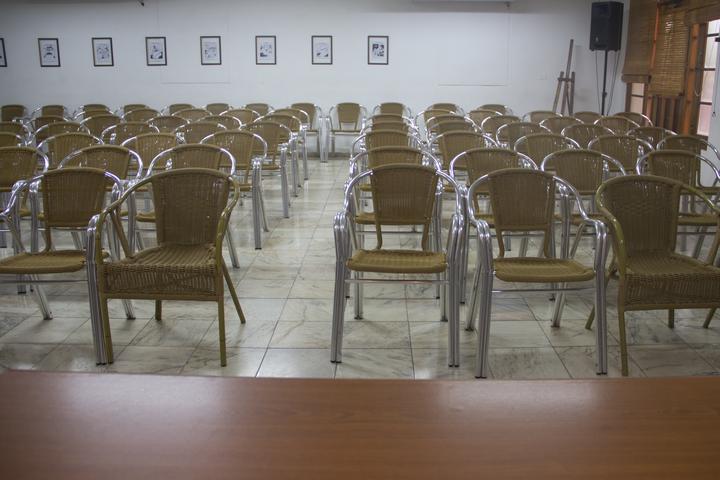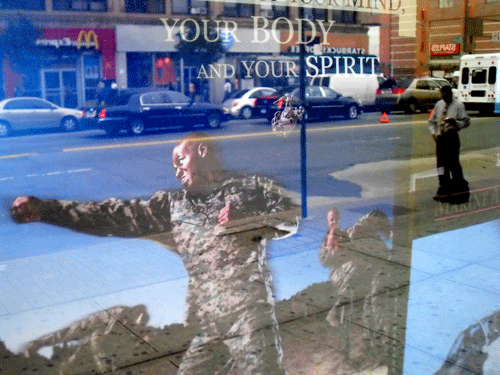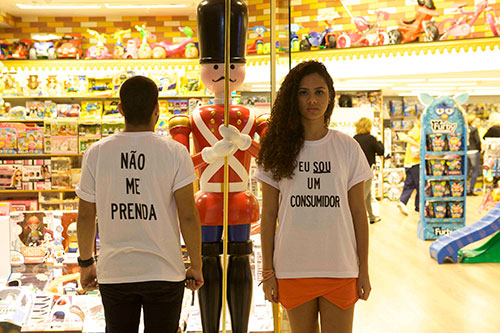
Coco Fusco (Cuban/American) is one of the artists in the group show ‘Ape Culture’ in Haus der Kulturen der Welt in Berlin.
From April 30 until June 6, 2015.
Still out of the Berlin performance.
This performance will be shown in Berlin.
Coco Fusco is a New York-based interdisciplinary artist, writer and Director of Intermedia Initiatives at Parsons The New School for Design. She has performed, lectured, exhibited and curated around the world since 1988. She is a recipient of a 2003 Herb Alpert Award in the Arts. Fusco’s performances and videos have been presented in two Whitney Biennials (2008 and 1993), the Sydney Biennale, The Johannesburg Biennial, The Kwangju Biennale, The Shanghai Biennale, InSite O5, the 2011 Mercosul Biennial, Transmediale, The London International Theatre Festival, VideoBrasil and Performa05. Her works have also been shown at the Tate Liverpool, The Museum of Modern Art, and the Museum of Contemporary Art in Barcelona.
 With the video ‘Confession’ she will be at the Venice Biennial 2015.
With the video ‘Confession’ she will be at the Venice Biennial 2015.
Fusco is the author of English is Broken Here: Notes on Cultural Fusion in the Americas (1995) and The Bodies that Were Not Ours and Other Writings (2001), and A Field Guide for Female Interrogators (2008). She is also the editor of Corpus Delecti: Performance Art of the Americas (1999) and Only Skin Deep: Changing Visions of the American Self (2003).
Fusco’s work combine electronic media and performance in a variety of formats, from staged multi-media performances incorporating large scale projections and closed circuit television to live performances streamed to the internet that invite audiences to chart the course of action through chat interaction. Her recent solo exhibition at Alexander Gray Associates featured her new video work The Empty Plaza/La Plaza Vacia. Inspired by the organized public protests in the Middle East beginning in 2011, the artist took note of the communal spaces around the world being utilized and, in contrast, those left empty.The empty Plaza de la Revolución in Havana, Cuba becomes the protagonist in Fusco’s meditation on public space, revolutionary promise, and memory. (press release)
 Harlem Postcards, 2008.
Harlem Postcards, 2008.
About the exhibition:
The exhibition Ape Culture presents artworks and documents that wittily observe the relationship between humans and other primates.
As a figure poised on the threshold between humans and animals, since antiquity the ape has played a central role in the story of how civilization has “progressed”. What was initially a means for Western humanity to define itself has become a test case for how human “nature” might be constructed anew – something that is uncharted territory where subconscious and unconscious notions of social order are revealed.
Ape Culture investigates the hegemonic and subversive potential of how apes are represented and reflects upon the term “culture.” In the exhibition, artists such as Ines Doujak, Pierre Huyghe, and Klaus Weber critically examine images of the great apes and their role in what Donna Haraway has termed the “primate order.” In addition, material taken from the natural sciences and popular culture illustrates how the way we perceive our closest relatives has changed radically. This is exemplified by Frederick Wiseman’s 1974 film “Primate,” an observation of the daily routine at Yerkes Primate Research Center in Atlanta. While on the surface the film documents the studies carried out by the center into apes’ capacity for learning, ability to remember, and sexual behavior, at a deeper level the film scrutinizes and challenges what science actually does: “One set of primates who have power, using it against another who haven’t,” as the British film critic Derek Malcolm put it. Coco Fusco’s “Observations of Predation in Humans: A Lecture by Dr. Zira, Animal Psychologist,” which will be shown as a film throughout the exhibition and performed live by the artist in early July, is based on the legendary female chimpanzee Dr. Zira from the film series “Planet of the Apes.” After twenty years of research in seclusion, Dr. Zira returns to the public sphere to present her assessment of the special characteristics of human aggression in the twenty-first century. (text museum)
 Still out of the performance ‘I am a consumer’, 2014
Still out of the performance ‘I am a consumer’, 2014
Eu Sou Um Consumidor (I Am a Consumer)
Performance | 2014
This participatory performance was inspired by the rolezinhos carried about by Brazilian youths of color. In 2013 in response to conditions of social apartheid that make it impossible for them to enter these sites of consumption without suffering harassment from police and private security, hundreds of youths began invading high-end shopping malls in Rio de Janeiro and Sao Paulo, until Brazilian judges ruled that their actions constituted illegal interference with commerce. For the performance, thirty Brazilian youths entered the Leblon Shopping Mall with T-shirts that said “I Am a Consumer” on the front and “Don’t Arrest Me” on the back. They proceeded en masse to the top floor where they purchased and consumed ice cream, and were followed and monitored by private security despite the presence of video cameras and production staff.
Photo: Janaína Miranda
Commissioned by the 2014 Transperformance Festival in Rio de Janeiro
